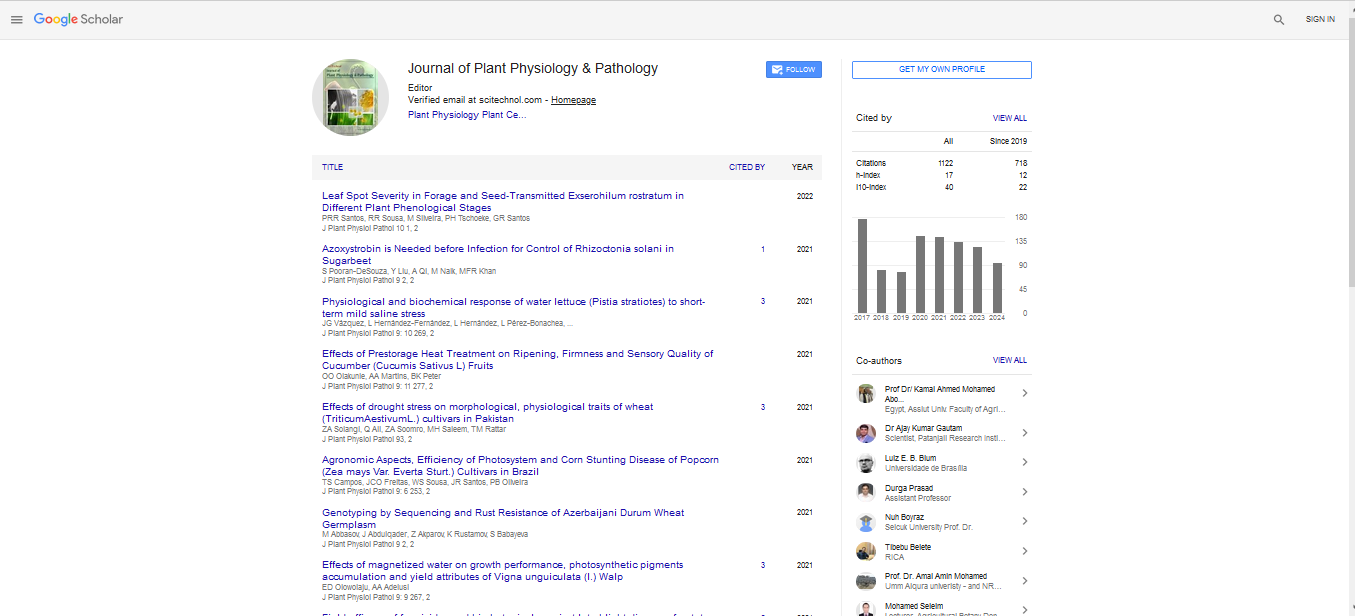Effect of different climatic regions and seasonal variation on the chemical profile of Helichrysum aureonitens Sch. Bip
Wilson Bamise Adeosun*, Olusola Bodede & Gerhard Prinsloo
University of South Africa, South Africa.
: J Plant Physiol Pathol
Abstract
Statement of the problem: Native South Africans make use of Helichrysum aureonitens Sch. Bip. extracts for the treatment of a variety of infections and they are important in traditional medicinal preparations. Traditional healers argue that the season of harvest has an impact on the curative properties of plants. Different studies have also reported the effect of different geographical locations on plant species. No study has however reported the effect of seasons and different growing locations on the chemical profile of any Helichrysum species. Attempts to determine the effects that both seasonal variation and environmental changes have on H. Aureonitens’ phytochemical compositions will therefore provide useful information about the phytochemical properties of the plant, which is important for obtaining the plant’s maximum active component concentrations. Methodology and Theoretical Orientation: Above ground plant material was collected in two different seasons: early spring, with high rainfall and high temperatures (October), and late autumn, with low rainfall and lower temperatures (May). Findings: Using 1H-NMR based metabolomics to analyse and compare the chemical profiles of the plant in both seasons and locations, the significant effects of the seasons and the peculiar climates of different localities on the secondary metabolite profile of H. aureonitens was confirmed. The result showed that the levels of aromatics are favoured in the wetter sites for both geographical locations in spring. Conclusion & Significance: Water availability is important for the production of high aromatics chemical in H. Aureonitens. Since this study is the first to report the effect of seasons and different climatic regions on any species of Helichrysum, the result can provide further insight into the effect of seasons and different geographical locations on the chemical profile of the nearly 500 species of the genus Helichrysum.
Biography
Prof. Dr. Vinay Sharma, Dean Research and Director, Amity Institute of Biotechnology at Amity University Rajasthan has over 36 years experience of teaching and research in Plant Sciences/ Biotechnlology. He has delivered over 120 invited/ keynote lectures and has chaired sessions at many national and international forums in India and abroad. He had extensive international research experience as Postdoc/ Visiting Professor at many institutions including Max Planck Institute, Koeln, Technical University, Darmstadt, Germany, University of Central Florida, USA and others. He has published over 350 research papers (i-10 index of 150, h index of 40 with over 6200 citations), authored 8 books and has mentored 75 doctoral students. He has been conferred with several prestigious recognitions and awards in India and abroad including Fellow of Science Academies and Societies in India. He has a keen interest in Plant Biology (Plant Stress/ Plant Informatics)/ Biotechnology) and his current major research focus is on Molecular Biology and Biochemistry of Plant Stress.
 Spanish
Spanish  Chinese
Chinese  Russian
Russian  German
German  French
French  Japanese
Japanese  Portuguese
Portuguese  Hindi
Hindi 
